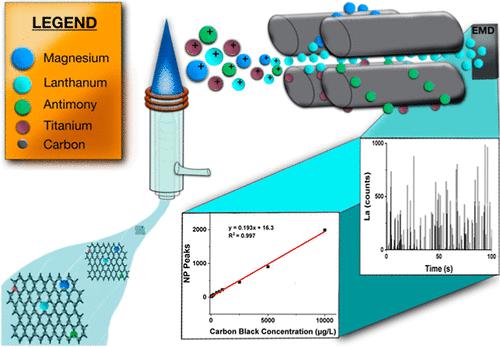当前位置:
X-MOL 学术
›
Environ. Sci. Technol.
›
论文详情
Our official English website, www.x-mol.net, welcomes your feedback! (Note: you will need to create a separate account there.)
Targeting Metal Impurities for the Detection and Quantification of Carbon Black Particles in Water via spICP-MS
Environmental Science & Technology ( IF 11.4 ) Pub Date : 2022-09-22 , DOI: 10.1021/acs.est.2c03130 Kenneth Flores 1 , Logan N Rand 2, 3 , Carolina Valdes 1 , Alexandria Castillo 1 , Jesus M Cantu 1 , Jason G Parsons 4 , Paul Westerhoff 2 , Jorge L Gardea-Torresdey 1
Environmental Science & Technology ( IF 11.4 ) Pub Date : 2022-09-22 , DOI: 10.1021/acs.est.2c03130 Kenneth Flores 1 , Logan N Rand 2, 3 , Carolina Valdes 1 , Alexandria Castillo 1 , Jesus M Cantu 1 , Jason G Parsons 4 , Paul Westerhoff 2 , Jorge L Gardea-Torresdey 1
Affiliation

|
Carbon black (CB) is a nanomaterial with numerous industrial applications and high potential for integration into nano-enabled water treatment devices. However, few analytical techniques are capable of measuring CB in water at environmentally relevant concentrations. Therefore, we intended to establish a quantification method for CB with lower detection limits through utilization of trace metal impurities as analytical tracers. Various metal impurities were investigated in six commercial CB materials, and the Monarch 1000 CB was chosen as a model for further testing. The La impurity was chosen as a tracer for spICP-MS analysis based on measured concentration, low detection limits, and lack of polyatomic interferences. CB stability in water and adhesion to the spICP-MS introduction system presented a challenge that was mitigated by the addition of a nonionic surfactant to the matrix. Following optimization, the limit of detection (64 μg/L) and quantification (122 μg/L) for Monarch 1000 CB demonstrated the applicability of this approach to samples expected to contain trace amounts of CB. When compared against gravimetric analysis and UV–visible absorption spectroscopy, spICP-MS quantification exhibited similar sensitivity but with the ability to detect concentrations an order of magnitude lower. Method detection and sensitivity was unaffected when dissolved La was spiked into CB samples at environmentally relevant concentrations. Additionally, a more complex synthetic matrix representative of drinking water caused no appreciable impact to CB quantification. In comparison to existing quantification techniques, this method has achieved competitive sensitivity, a wide working range for quantification, and high selectivity for tracing possible release of CB materials with known metal contents.
中文翻译:

通过 spICP-MS 靶向金属杂质检测和定量水中的炭黑颗粒
炭黑 (CB) 是一种具有众多工业应用的纳米材料,并且具有集成到纳米水处理装置中的巨大潜力。然而,很少有分析技术能够以环境相关浓度测量水中的 CB。因此,我们打算通过利用痕量金属杂质作为分析示踪剂,建立一种检测限较低的 CB 定量方法。研究了六种商用 CB 材料中的各种金属杂质,并选择 Monarch 1000 CB 作为模型进行进一步测试。选择 La 杂质作为 spICP-MS 分析的示踪剂是基于测量的浓度、低检测限和无多原子干扰。CB 在水中的稳定性和对 spICP-MS 引入系统的附着力是一个挑战,通过在基质中添加非离子表面活性剂可以缓解这一挑战。经过优化,Monarch 1000 CB 的检测限 (64 μg/L) 和定量限 (122 μg/L) 证明了这种方法对预期含有痕量 CB 的样品的适用性。与重量分析和紫外-可见吸收光谱相比,spICP-MS 定量显示出相似的灵敏度,但检测浓度的能力要低一个数量级。当溶解的 La 以环境相关浓度加标到 CB 样品中时,方法检测和灵敏度不受影响。此外,代表饮用水的更复杂的合成基质对 CB 定量没有明显影响。
更新日期:2022-09-22
中文翻译:

通过 spICP-MS 靶向金属杂质检测和定量水中的炭黑颗粒
炭黑 (CB) 是一种具有众多工业应用的纳米材料,并且具有集成到纳米水处理装置中的巨大潜力。然而,很少有分析技术能够以环境相关浓度测量水中的 CB。因此,我们打算通过利用痕量金属杂质作为分析示踪剂,建立一种检测限较低的 CB 定量方法。研究了六种商用 CB 材料中的各种金属杂质,并选择 Monarch 1000 CB 作为模型进行进一步测试。选择 La 杂质作为 spICP-MS 分析的示踪剂是基于测量的浓度、低检测限和无多原子干扰。CB 在水中的稳定性和对 spICP-MS 引入系统的附着力是一个挑战,通过在基质中添加非离子表面活性剂可以缓解这一挑战。经过优化,Monarch 1000 CB 的检测限 (64 μg/L) 和定量限 (122 μg/L) 证明了这种方法对预期含有痕量 CB 的样品的适用性。与重量分析和紫外-可见吸收光谱相比,spICP-MS 定量显示出相似的灵敏度,但检测浓度的能力要低一个数量级。当溶解的 La 以环境相关浓度加标到 CB 样品中时,方法检测和灵敏度不受影响。此外,代表饮用水的更复杂的合成基质对 CB 定量没有明显影响。



























 京公网安备 11010802027423号
京公网安备 11010802027423号